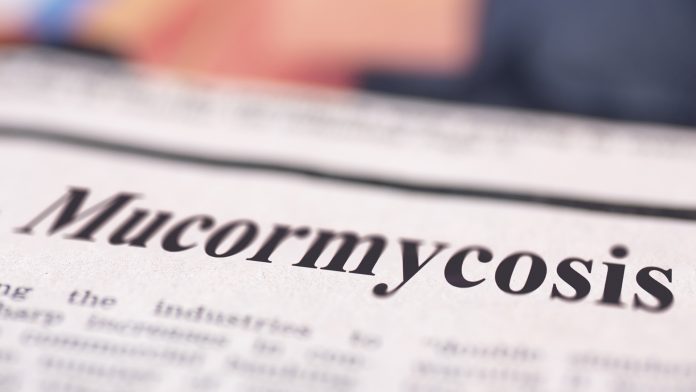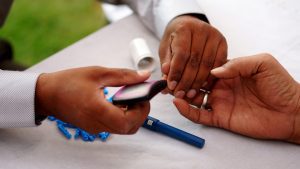
Martin Hoenigl, the President of the European Confederation of Medical Mycology, discusses the challenges of diagnosing and treating mucormycosis.
Mucormycosis is perhaps not a term you were familiar with prior to the COVID-19 outbreak. However, the profile of this rare fungal disease has been rising in tandem with COVID-19 cases, particularly in under-resourced countries. Earlier this year, as the Delta variant of COVID-19 started to spread, cases of patients suffering from the so-called ‘black fungus’ began to mulitply, causing thousands of fatalities in its wake.
While not the primary cause of the infection, physiological damage incurred as a result of COVID-19, and its consequential treatment, has triggered a surge in mucormycosis cases. Combined with issues around the availability of medical equipment and resources, medicine misuse, environmental exposure, and high levels of undiagnosed chronic diseases, many critically ill patients have been unable to offset the infection caused by these ubiquitous spores.
The European Confederation of Medical Mycology (ECMM) works to facilitate cross-border collaboration in the research and training around infectious diseases. As part of its work to improve diagnostic procedures and treatment for mucormycosis, the ECMM recently launched the One World One Guideline initiative to improve clarification on clinical procedures around mucormycosis, and other fungal diseases, and encourage participation and knowledge sharing between physicians, scientists, and researchers throughout the world. HEQ spoke to Martin Hoenigl who is President of ECMM about the challenges facing the diagnosis and treatment of mucormycosis.
To begin, can you give me an overview of the ECMM and its main objectives?
The ECMM is a confederation of 28 European societies in the field of medical mycology. These societies each choose a representative to be part of the ECMM council, which elects a board of three every three years. When the ECMM was founded in 1993, for a long time our main focus was Europe and though Europe is still central to our work, we now have more of a worldwide approach. Our Trends in Medical Mycology (TIMM) Conference, which takes place every two years, welcomes participants from all over the world and therefore, has encouraged us to introduce different worldwide initiatives into the ECMM and establish a wide network of ECMM fellows. Additionally, we have a growing network of worldwide ECMM Excellence Centres which help to strengthen countries’ medical resources, training and research programmes.
The ECMM recently started a worldwide guidance initiative and one of our main goals was to bring global organisations together to establish one guide for mucormycosis initially, and subsequently other fungal diseases. 60 societies from around the world endorsed our guideline which was really encouraging, and a supporting paper entitled “Global guideline for the diagnosis and management of mucormycosis” can now be viewed in The Lancet Infectious Diseases. In the meantime, three additional guidelines out of the same initiative have been published in the same journal. Another improvement on previous guidelines is that the ECMM can offer algorithms that can be adapted based on the availability of treatment or resources in a specific area, therefore we can offer more suitable and manageable solutions. This global guideline will help strengthen diagnostic procedures and clinical care around mucormycosis so that this disease and others can be managed more effectively.
Can you describe mucormycosis?
Mucormycosis is an invasive mould infection that is caused by exposure to mucoralean fungi which are collectively referred to as Mucorales. Mucor spores are present throughout the environment in various degrees and essentially harmless to most humans, however when people are unwell or being treated for other illnesses, they can become more susceptible to the fungal infection.
Mucormycosis is a rare but invasive disease comprising a number of pathogens with the most common being the Rhizopus, Mucor, and Lichtheimia species, and these pathogens have different patterns of disease that they can cause. Immunocompromised patients, who catch the infection via inhalation of sporangiospores, can develop a pulmonary infection which can rapidly spread to other areas of the body. Similarly, those with comorbidities, skin trauma or haematological malignancies are also at risk and could have poor outcomes not seen in previously healthy patients.
Symptoms of mucormycosis may be less characteristic if a patient is also suffering from COVID-19 but generally it can start with a headache, cough, fever, and/or chest pain. More aggressive symptoms can include gastrointestinal bleeding, black lesions, diarrhoea, swelling and nausea. Vision can also be affected because of mounting pressure behind the eye, and likewise, damage to cerebral nerves can cause fatal injury to the brain.
Cases of mucormycosis have been increasing in tandem with COVID-19, what would you attribute this increase in cases to?
COVID-19 can affect pulmonary health and immunity and we have seen a lot of COVID-associated pulmonary aspergillosis in nations around the world. We have also seen COVID-associated mucormycosis in patients who did not necessarily bear many of the previously known risk factors prior to becoming infected. What is striking about the mucormycosis infection is that it is growing aggressively, even more aggressively than aspergillus, and this dissemination is a great threat to patients because it can affect other tissues and organs. COVID-19 is thought to be a contributing risk factor for mucormycosis because it can make patients more susceptible to infection and the treatments being used to treat COVID can include immunosuppressant steroids, which while helping to reduce inflammation in the lungs can also make patients more vulnerable to moulds and spores in the surrounding environment.
Comorbidities are another risk factor: hematologic malignancy or uncontrolled diabetes, especially the latter, can be a huge challenge in many low-to-middle income countries, can make people more susceptible to infection. For example, if a patient presents diabetic ketoacidosis (DKA) which can increase the levels of free iron in their serum this can, in turn, cause increased numbers of harmful mucor pathogens which can use this iron to spread. There is a lot of unbound iron within a patient suffering from COVID-19 and therefore the pathogens associated with mucormycosis can use this iron to multiply and grow. That is one of the mechanisms that COVID itself may predispose.
Another contributing factor is a heightened exposure to fungal spores. Mucor spores can be found in the environment, but they can also be present in hospital settings, they are not necessarily the route cause of the spread, however they can be harmful to patients who are more vulnerable to infections. We all have a certain amount of moulds within us but when we are fit and healthy, these are usually not a threat.
The high numbers of COVID-19 infections in India are devasting when you look at disease outcomes. This was already a susceptible nation with a high environmental burden of Mucorales before COVID and now with COVID, there was not enough oxygen around and at the same time corticosteroids, which are available over the counter in India, are being use too generously to treat disease. Lack of clear information, corticosteroids misuse, environmental exposure and uncontrolled diabetes may all contribute to the pathogenesis of mucormycosis.

The mucormycosis disease manifestation we are seeing, by far the most often in South Asia at the moment is the renal cerebral form, which basically starts with sinusitis but can develop to affect other organs particularly the eyes and the brain.1 This may, however, also have to do with the fact that the pulmonary form of disease is much harder to diagnose and may simply be missed.
What treatments are available for mucormycosis patients, particularly for those who are also tackling COVID-19?
Treatment pathways are dependent on patients’ individual condition and also by what treatments are available in their specific clinical settings. Mucormycosis can develop rapidly so it is important to diagnose and treat it early and optimally, have surgeons involved early on to give patients the best chance of survival.
As an initial step following a physical examination, imaging tests may be carried out to see if the infection has spread to the patient’s organs. Surgical debridement may be required soon after confirmation of mucormycosis to help curb the spread of the disease. This surgery would be recommended in tandem with anti-fungal medications which can include primarily lipid formulations of amphotericin B, and as alternatives isavuconazole and posaconazole that can halt growth and destroy the fungus in the body. Our guidelines recommend a high dose of liposomal amphotericin B as a first line treatment as this is the most effective, but this would depend on whether the patient already has any damage to their kidneys.
Traditionally, amphotericin B deoxycholate was used widely in the 80s and 90s but this could have severe side effects and exacerbate damage to the organs. The industry therefore needed to push for innovation in this field so that medications could be created with much less risk of causing permanent damage. In most places around the world, they will use alternatives to amphotericin B deoxycholate, however, for many low- and middle-income countries where resources are limited, even more so because of the pandemic, they may have no other choice than to use amphotericin B deoxycholate.
In our guidelines, we recommend different treatment pathways dependent on a patient’s condition. Early diagnosis of mucormycosis as well as recognising patterns in the disease is extremely important.
What actions can clinical and care facilities take to minimise the risk of patients and staff contracting mucormycosis?
It is not so much actions that clinical staff can take to reduce infections within the clinical setting as intrahospital transmission is probably not the prime driver of the disease, more so, it is breaking down the risk factors and understanding why there are increased numbers of susceptible hosts in certain parts of the word. We are all exposed to moulds and spores in the environment, but it does not necessarily mean we will go on to develop a fungal infection. The most important thing now is to secure enough medical supplies to treat patients effectively. Similarly, we need to work to reduce the number of susceptible hosts, and one of the ways to do this is to reduce the excess use of corticosteroids and therefore increase the number of available ventilators so that people do not feel the need to repeatedly use those corticosteroids to reduce their symptoms and manage the infection. Another solution would be to curb the amount of uncontrolled diabetes. This requires more information sharing, improved diagnostic procedures and availability of care and treatment for diabetes sufferers early on. Many cases of diabetes go undiagnosed making people more at risk of catching COVID-19.
We need to remember that cases of mucormycosis in India is something that is being widely reported on because doctors there are more aware of what symptoms to look out for. Therefore, this is not to say that rising cases of mucormycosis are not occurring in other parts of the world, particularly those that have limited resources. While broad media coverage has helped to raise awareness, not all physicians who see these patients with sinusitis would immediately be aware that it could be mucormycosis and so it is entirely possible that these infections are misdiagnosed and not suitably treated. We have recently published guidance relating to COVID-19 associated mucormycosis (CAM) which includes information of mucormycosis symptoms, treatment, and prevention.2
References
- https://papers.ssrn.com/sol3/papers.cfm?abstract_id=3844587
- https://onlinelibrary.wiley.com/doi/epdf/10.1111/myc.13335
Martin Hoenigl, MD, FECMM
Associate Professor of Medicine, Division of Infectious Diseases and Global Public Health, UCSD and Division of Infectious Diseases, Medical University of Graz, Graz, Austria
Head of the Clinical and Translation Fungal Research UCSD Working Group
President of the ECMM
https://www.ecmm.info/
This article is from issue 19 of Health Europa Quarterly. Click here to get your free subscription today.








